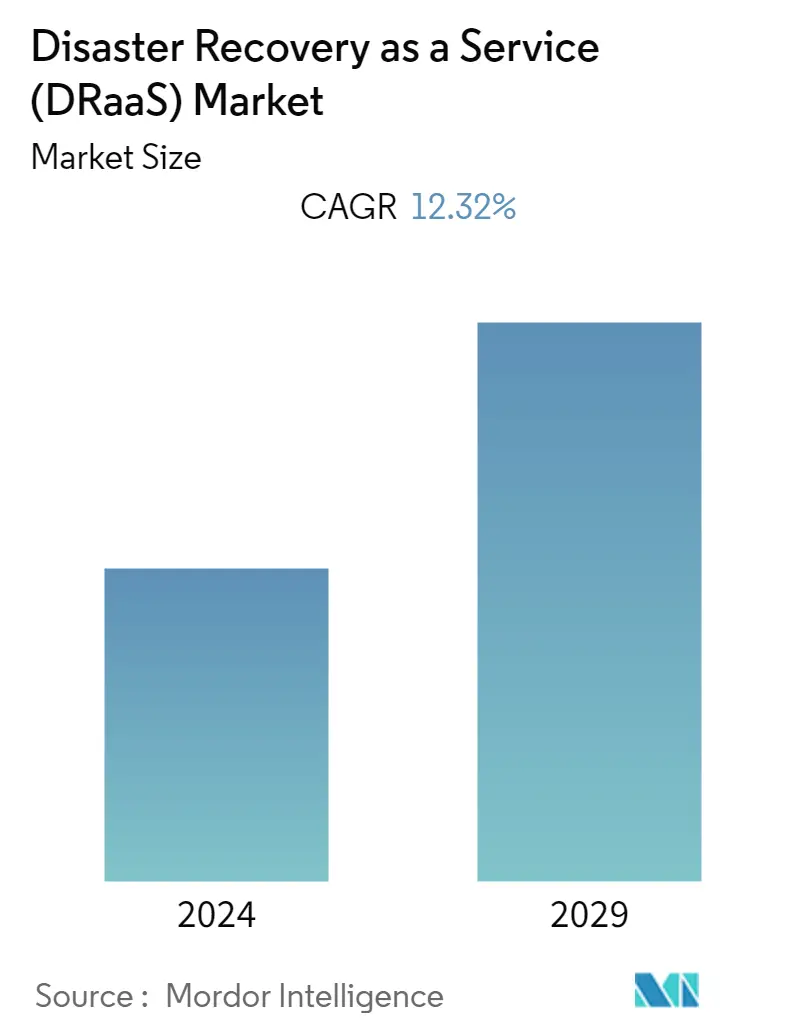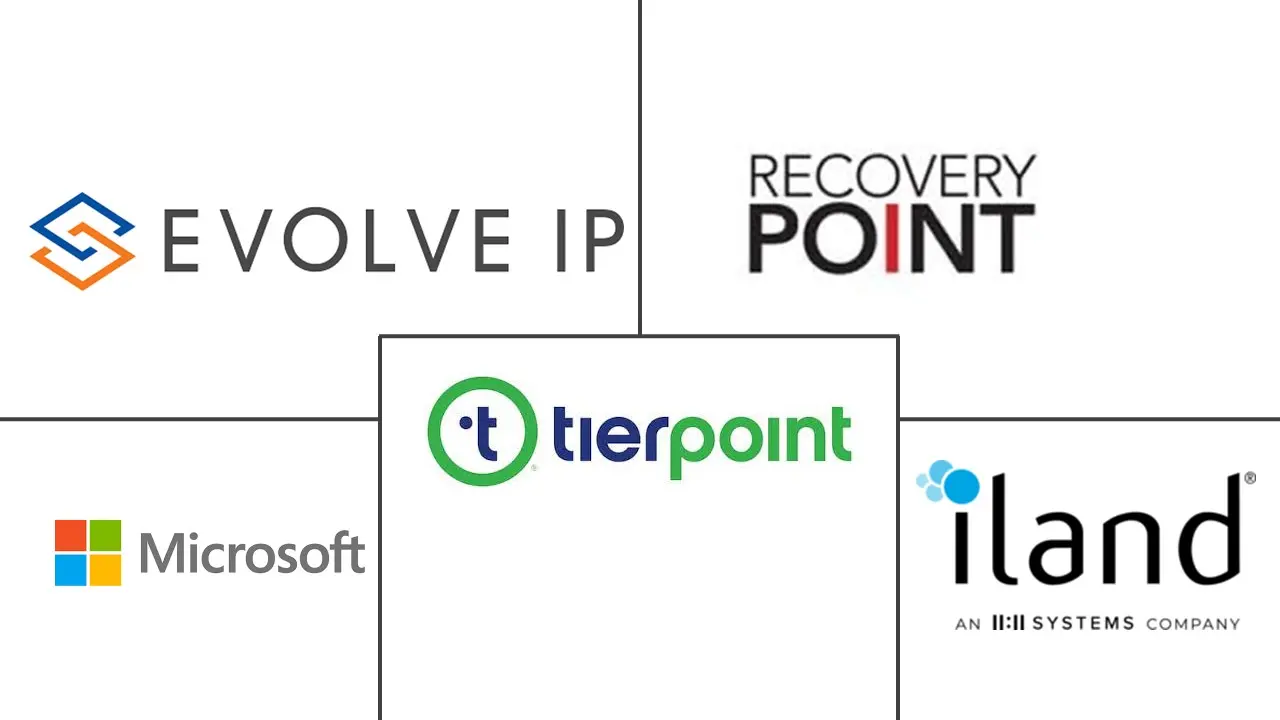Market Size of Disaster Recovery as a Service (DRaaS) Industry

| Study Period | 2019 - 2029 |
| Base Year For Estimation | 2023 |
| CAGR | 12.32 % |
| Fastest Growing Market | North America |
| Largest Market | Asia-Pacific |
| Market Concentration | Low |
Major Players
*Disclaimer: Major Players sorted in no particular order |
Disaster Recovery as a Service Market Analysis
The Disaster Recovery as a Service (DRaaS) Market is expected to register a CAGR of 12.32% over the forecast period. Disaster Recovery as a Service (DRaaS) is generally utilized by organizations facing an event where recovery capabilities are quickly needed. Time-to-value concerns and ongoing care and feeding are essential considerations. The services typically include:
- An on-demand recovery cloud for planned tests, exercises, and declarations. Server image and production data replication to the cloud, automated failover and failback between production and the target cloud environment, and recovery time service-level agreements (SLAs).
- Initially, DRaaS solutions were considerably implemented by small businesses that didn't have secondary sites or were eliminating data centers to reduce costs. However, DRaaS is also preferred by larger organizations in the modern landscape, as providers have reported an increase in large and complex environments and the volume of servers per client. The drivers in the studied market include increasing data breaches and ransomware attacks, creating a need for robust data protection solutions, and reducing the operational cost of DRaaS solutions compared to traditional solutions.
- The players in the market are expected to increase market capture and reduce customer friction by offering enhanced onboarding options and additional capabilities in support of various recovery targets, platforms supported (i.e., beyond VMware and physical x86), and international aid and bolster DRaaS solutions with built-in add-ons like automated recovery testing and change management assurance.
- The DRaaS market consists of multiple players with varying abilities to support requirements. These can relate to workload types, geographies, scale, onboarding, ongoing support levels, the number of recovery point objective (RPO) and recovery time objective (RTO) options, and target recovery locations. The provider may deliver fully managed, assisted recovery or self-service services.
- On the other hand, customers may need to be made aware of what they have in their data centers. They must be aware of their various IT assets and how their criticality translates into the service tiers of a DRaaS provider. The service provider's replication method generally gives different recovery periods at other price points. The most costly tier may offer workload recovery in seconds or minutes. In contrast, the mid-tier may offer a 4-to-8-hour enterprise workload recovery time, and the least expensive tier may offer a 24-to-48-hour recovery.
- A nationwide lockdown across the globe marked the pandemic, and company employees have begun to work remotely. The increased dependency on the security of data measures was brought to light by several data breaches and an increase in cyberattacks. Furthermore, ransomware attacks have increased significantly during the pandemic, which has underlined the need for disaster recovery solutions to prevent the downtime of systems that could result in severe losses for organizations.
Disaster Recovery as a Service Industry Segmentation
The disaster recovery as a service (DRaaS) market provides for the recovery of enterprise applications at another location in the event of a disaster. The provider can deliver the service as a fully-managed, assisted recovery or self-service offering.
The agility of disaster recovery in the cloud affords businesses a geographically diverse location to failover operations and run as close to normal as possible following a disruptive event.
The Disaster Recovery as a Service (DRaaS) Market is segmented by End-user Vertical (BFSI, IT, Government, and Healthcare) and Geography (North America, Europe, Asia-Pacific).
The market sizes and forecasts are provided in terms of value (USD million) for all the above segments.
| End-user Vertical | |
| BFSI | |
| IT | |
| Government | |
| Healthcare | |
| Other End-user Verticals |
| Geography | |
| North America | |
| Europe | |
| Asia Pacific | |
| Rest of the World |
Disaster Recovery as a Service (DRaaS) Market Size Summary
The Disaster Recovery as a Service (DRaaS) market is experiencing significant growth, driven by the increasing need for organizations to quickly recover from disruptive events. This service is essential for businesses facing data breaches and ransomware attacks, as it offers robust data protection solutions and cost-effective alternatives to traditional recovery methods. Initially popular among small businesses lacking secondary sites, DRaaS has gained traction among larger organizations due to its ability to support complex environments and numerous servers per client. The market is characterized by a diverse range of providers offering various levels of support, recovery options, and service tiers, catering to different organizational needs and budgets. The pandemic has further highlighted the importance of DRaaS, as remote work and cyberattacks have underscored the necessity of secure data recovery solutions.
The BFSI sector is poised to adopt DRaaS solutions extensively, as financial institutions prioritize uninterrupted customer service to maintain their reputations. The shift towards cloud-based services is driven by the need for optimized infrastructure and compliance with regulatory standards. In the United States, a major market for DRaaS, the demand is fueled by the increasing frequency of data breaches and the government's support for cybersecurity initiatives. Prominent players like IBM and Microsoft are enhancing their market presence through innovations and strategic partnerships. The competitive landscape is marked by collaborations and advancements in data protection technologies, with companies like FalconStor and Otava offering tailored solutions for hybrid cloud environments. These developments are shaping the future of DRaaS, making it a critical component of organizational resilience and cybersecurity strategies.
Disaster Recovery as a Service (DRaaS) Market Size - Table of Contents
-
1. MARKET INSIGHTS
-
1.1 Market Overview
-
1.2 Industry Attractiveness - Porter's Five Forces Analysis
-
1.2.1 Bargaining Power of Suppliers
-
1.2.2 Bargaining Power of Consumers
-
1.2.3 Threat of New Entrants
-
1.2.4 Intensity of Competitive Rivalry
-
1.2.5 Threat of Substitute Products
-
-
1.3 Assessment of Impact of COVID-19 on the Market
-
1.4 Technology Snapshot
-
1.4.1 Fully Managed
-
1.4.2 Assisted
-
1.4.3 Self Service
-
-
-
2. MARKET SEGMENTATION
-
2.1 End-user Vertical
-
2.1.1 BFSI
-
2.1.2 IT
-
2.1.3 Government
-
2.1.4 Healthcare
-
2.1.5 Other End-user Verticals
-
-
2.2 Geography
-
2.2.1 North America
-
2.2.2 Europe
-
2.2.3 Asia Pacific
-
2.2.4 Rest of the World
-
-
Disaster Recovery as a Service (DRaaS) Market Size FAQs
What is the current Disaster Recovery as a Service (DRaaS) Market size?
The Disaster Recovery as a Service (DRaaS) Market is projected to register a CAGR of 12.32% during the forecast period (2024-2029)
Who are the key players in Disaster Recovery as a Service (DRaaS) Market?
iLand Internet Solutions Corporation, Microsoft Corporation, Recovery Point Systems Inc., Evolve IP LLC and TierPoint, LLC are the major companies operating in the Disaster Recovery as a Service (DRaaS) Market.

